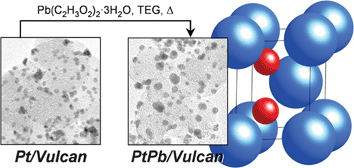Converting nanocrystalline metals into alloys and intermetallic compounds for applications in catalysis
Abstract
Multi-metal

* Corresponding authors
a Department of Chemistry, Texas A&M University, P.O. Box 30012, College Station, TX 77842-3012, USA
b
Department of Chemistry, Pennsylvania State University, 104 Chemistry Building, University Park, PA 16802, USA
E-mail:
schaak@chem.psu.edu
Multi-metal

 Please wait while we load your content...
Something went wrong. Try again?
Please wait while we load your content...
Something went wrong. Try again?
J. C. Bauer, X. Chen, Q. Liu, T. Phan and R. E. Schaak, J. Mater. Chem., 2008, 18, 275 DOI: 10.1039/B712035D
To request permission to reproduce material from this article, please go to the Copyright Clearance Center request page.
If you are an author contributing to an RSC publication, you do not need to request permission provided correct acknowledgement is given.
If you are the author of this article, you do not need to request permission to reproduce figures and diagrams provided correct acknowledgement is given. If you want to reproduce the whole article in a third-party publication (excluding your thesis/dissertation for which permission is not required) please go to the Copyright Clearance Center request page.
Read more about how to correctly acknowledge RSC content.
 Fetching data from CrossRef.
Fetching data from CrossRef.
This may take some time to load.
Loading related content
